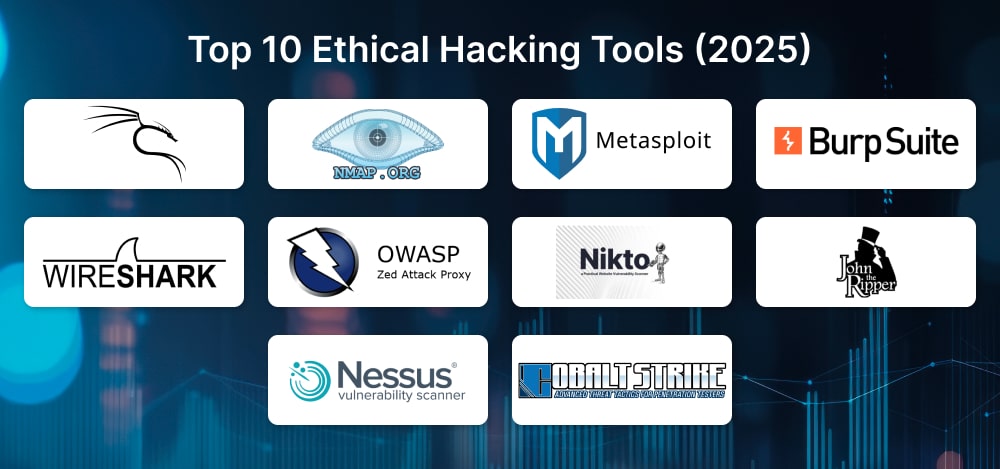
Ethical hacking, also known as white-hat hacking, is the practice of utilizing hacking skills to enhance, rather than compromise, digital systems. Unlike malicious hackers, ethical hackers work with permission to probe networks, applications, and infrastructure, uncovering vulnerabilities before cybercriminals can exploit them.
With cyberattacks growing in scale and sophistication, ransomware costs are expected to exceed $265 billion annually by 2031. Organizations can no longer rely on reactive security. They need proactive defenses, and ethical hacking tools are at the center of this strategy.
These tools allow professionals to simulate real-world attack scenarios, test defenses, and uncover weaknesses across applications, networks, and user access points. From penetration testing frameworks to vulnerability scanners and password-cracking utilities, each tool plays a unique role in building resilient digital systems.
In this blog, we’ll explore the Top 10 Ethical Hacking Tools of 2025, explain how they work, and highlight where they fit in an ethical hacker’s toolkit. If you’re an aspiring penetration tester, a security professional, or a leader responsible for safeguarding enterprise systems, mastering these tools will help you stay ahead of today’s evolving cyber threats.
Top 10 Ethical Hacking Tools (2025)
Ethical hacking isn’t about guessing passwords in a dark room, , it’s about using the right tools to simulate attacks, uncover weaknesses, and strengthen defenses. In 2025, the ethical hacker’s toolkit includes a mix of open-source classics and enterprise-grade platforms, each serving a different phase of penetration testing: reconnaissance, exploitation, password auditing, web security, and advanced threat simulation.
The following 10 tools represent the most relevant and widely used in the field today. They have been selected not just for their popularity, but also for their practical value to ethical hackers across various industries, including testing web applications and scanning networks, as well as simulating nation-state attacks.
1. Kali Linux – The Swiss Army Knife of Ethical Hacking
Kali Linux is an open-source, Debian-based operating system meticulously crafted for cybersecurity professionals, ethical hackers, and digital forensic specialists. Maintained by Offensive?Security, it offers a rolling-release model with rich support across architectures, from x86 to ARM (including cloud, containers, WSL, and mobile)
Core Strengths
- Extensive Toolset: Ships with 600+ bundled tools, covering everything from network scanning and exploitation to forensics and wireless attacks
- Ready?to?use Platform: Unlike generic Linux distros, Kali comes preconfigured with tools and environments optimized for penetration testing
- Highly Flexible: Available as live USB, VM image, ARM build, cloud deployment, WSL (via Win-KeX), or mobile (NetHunter)
- Active Support & Learning: Regular updates, strong community forums, official documentation, and training like OSCP or KLCP make it a complete ecosystem
How Professionals Use It?
- Penetration Testing & Vulnerability Assessment
Kali’s arsenal of scanners and tools, from Nmap to Metasploit to Wireshark, powers all phases of ethical hacking, helping security teams uncover exploitable weaknesses
- Capture the Flag (CTF) Training
Widely adopted in cybersecurity competitions, Kali provides the full stack of tools (like John the Ripper, sqlmap, and Metasploit) that participants need to solve real-world challenge scenarios
- Forensics, Incident Response & Malware Analysis
With built-in capabilities for disk imaging, log examination, memory forensics, and malware reverse-engineering, Kali is invaluable in breach investigation workflows
Real-World Snapshot: Misconfigured Firewall Exposes Sensitive DataA July 2025 report detailed how an ethical hacking team used Kali Linux during a corporate security audit. They discovered a misconfigured firewall that inadvertently exposed sensitive internal services to the internet. Leveraging Kali’s Nmap and vulnerability scanners, the team quickly identified the open services, exploited the misconfiguration in a controlled environment, and guided remediation steps, potentially averting a serious security breach. |
2. Nmap – The Network Cartographer
When ethical hackers talk about “seeing the unseen,” they’re often referring to Nmap (Network Mapper). Originally released in 1997, this open-source tool remains the go-to scanner for uncovering what lives on a network, devices, services, ports, and even subtle fingerprints that hint at operating systems.
Unlike many modern commercial scanners, Nmap thrives because of its simplicity and precision. It doesn’t overwhelm; it maps. And in cybersecurity, visibility is often the first battle won.
Why Nmap Still Reigns in 2025?
- Port Scanning Excellence: Detects open, filtered, or closed ports with high accuracy.
- Service & Version Detection: Identifies running applications (e.g., Apache, MySQL) and their versions.
- OS Fingerprinting: Reveals operating systems by analyzing packet responses.
- Scriptable Flexibility: The Nmap Scripting Engine (NSE) allows users to automate checks, from brute-force logins to malware detection.
- Scalability: Equally effective at probing a single IP or scanning millions of hosts.
Practical Applications
- For Ethical Hackers: A reconnaissance powerhouse to plan penetration tests.
- For Network Admins: Rapidly audit live systems, rogue devices, or unauthorized open ports.
- For Enterprises: Integrate Nmap into CI/CD pipelines for DevSecOps scans.
- For Researchers: Explore internet-wide security trends, as seen in studies by Shodan and Censys.
Case Study: Nmap in a Financial Institution’s Security AuditIn 2025, a mid-sized financial institution commissioned an ethical hacking engagement to evaluate its security posture. During the reconnaissance phase, penetration testers deployed Nmap to scan critical systems across the internal and external networks. The scans revealed:
Armed with this map of the network, testers demonstrated how an attacker could pivot from a low-privilege system to sensitive financial applications. The findings prompted the institution to tighten firewall rules, patch legacy applications, and implement stricter network segmentation. Impact: According to the final report, the institution reduced its risk of cyberattack success by more than 60% after remediation efforts guided by Nmap’s visibility. |
3. Metasploit – Turning Vulnerabilities into Lessons
Metasploit is more than a tool; it’s a penetration testing framework that lets ethical hackers simulate real-world attacks in a controlled way. Think of it as a sandbox for security testing. With over 2,000 exploits and 500 payloads, it helps users practice how attackers operate, without causing harm.
Why Professionals Use It?
For working pentesters and security engineers, Metasploit offers:
- Exploit Testing – Verify if known vulnerabilities in systems can be successfully exploited.
- Payload Simulation – Deploy realistic attacker payloads, such as Meterpreter, to test detection.
- Integration – Import Nmap or Nessus results and immediately test them with real exploits.
- Red/Blue Team Training – Run drills to help defenders see, detect, and stop simulated attacks.
Real-World Case Study: FBI’s “Operation Torpedo” – Unmasking Tor Users with MetasploitIn 2012, the FBI orchestrated a covert operation known as “Operation Torpedo” to identify users accessing illicit websites via the anonymizing Tor network. Their tool of choice: the Metasploit Decloaking Engine, a module within Metasploit designed to exploit browser vulnerabilities and bypass anonymity.
Metasploit’s versatility isn’t limited to penetration testing labs; it can be used in real-world operations, including law enforcement investigations. This underscores the dual-edged nature of hacking frameworks: they are powerful in defense, but also potent in offensive scenarios. |
4. Burp Suite – The Web’s X-Ray Machine
Web applications are the front door of modern business, and attackers’ favorite entry point. Burp Suite, developed by PortSwigger, is the most trusted toolkit for web application penetration testing (PortSwigger).
Unlike scanners that only skim surfaces, Burp acts like an X-ray, intercepting, modifying, and replaying traffic between the browser and server. This lets ethical hackers uncover hidden vulnerabilities like:
- SQL Injection
- Cross-Site Scripting (XSS)
- Cross-Site Request Forgery (CSRF)
- Authentication flaws
Key Features That Matter in 2025
- Proxy Interception: Capture and analyze HTTP/S requests in real time.
- Automated Scanner: Detects 100+ categories of vulnerabilities, including OWASP Top 10.
- Intruder Module: Automates fuzzing and brute-force testing on inputs.
- Repeater & Sequencer: Replay requests or test session randomness.
- CI/CD Integration: Enterprise edition integrates into pipelines for DevSecOps.
Why is it an Industry Standard?
Burp Suite is used in most professional penetration testing engagements, bug bounty programs, and secure SDLC processes. Its adaptability, manual testing depth, plus automation make it equally valuable for ethical hackers sharpening their skills and enterprises safeguarding applications.
5. Wireshark – The Black Box Recorder of Networks
If Burp Suite is the web’s X-ray, Wireshark is the black box recorder of networks. It captures, inspects, and decodes packets in real-time, providing unparalleled visibility into what’s happening behind the scenes (Wireshark.org).
Why It Stands Out
- Protocol Analysis: Supports 2,000+ protocols, from HTTP to obscure IoT formats.
- Live & Offline Capture: Monitor in real time or analyze saved pcap files.
- Troubleshooting Power: Quickly isolate issues like misconfigurations, failed handshakes, or suspicious traffic.
- Free & Community-Driven: Open-source, widely supported, and constantly updated.
Real-World Insight: Incident Response & ForensicsWhile a direct real-world case like Target’s breach hasn’t publicly documented Wireshark use, network forensics universally relies on packet analysis tools like Wireshark to reconstruct attack timelines, follow data exfiltration, and detect persistent command-and-control communication attempts. For example:
|
6. OWASP ZAP – The DevSecOps Sentinel
The OWASP Zed Attack Proxy (ZAP) is an open-source dynamic application security testing (DAST) tool maintained by the OWASP Foundation. Built by a global community, ZAP is widely used for discovering vulnerabilities in web apps like XSS, SQL Injection, and misconfigurations, making it a go-to for developers, testers, and ethical hackers who want a reliable, cost-free solution (OWASP).
Why Ethical Hackers Use It
- Beginner-Friendly: Wizards and GUIs simplify learning.
- OWASP Alignment: Keeps pace with the OWASP Top 10 threats.
- Automation Ready: Integrates into CI/CD pipelines for shift-left testing.
- Community Driven: Frequent plugin updates from contributors worldwide.
Case Study: Integrating ZAP into CI/CD at a Fintech StartupA fintech company building a mobile-first banking app integrated ZAP into its Jenkins CI/CD pipeline. Each code push triggered automated ZAP scans that flagged:
Because ZAP was automated early, developers were able to patch flaws before the production release, saving remediation costs and protecting customer data from potential exploitation. |
7. Nikto – The Web Server Watchdog
Nikto is a long-standing, open-source web server scanner developed by Chris Sullo. Known for breadth over stealth, it identifies outdated server versions, dangerous files, and common misconfigurations across thousands of checks.
Why Ethical Hackers Use It?
- Breadth of Coverage: Scans 6,700+ potentially dangerous files/programs.
- SSL/TLS Support: Detects weak ciphers and certificate issues.
- Multiple Output Formats: Generates HTML, XML, or CSV reports for teams.
- Cross-Platform: Works seamlessly across Linux, macOS, and Windows.
Practical Use Scenario: Lean Vulnerability Scanning for Budget-Conscious OrganizationsOne security practitioner shared how Nikto became their go-to for low-cost scans of legacy or static websites, especially in resource-constrained environments (e.g., nonprofits). It quickly revealed missing headers, open directories, and outdated server software, providing actionable intelligence without requiring heavyweight tools. |
8. John the Ripper – Testing the Strength of Passwords
Passwords remain one of the weakest links in security, and John the Ripper (JtR) is the classic tool for ethical hackers to expose that weakness. It’s an open-source password-cracking utility capable of handling dozens of hash formats, from simple DES to NTLM, SHA, and Kerberos.
Why Ethical Hackers Use It?
- Audit User Passwords: Test if employees are still using weak or default credentials.
- Practice Cracking Techniques: Combine dictionary, brute-force, and hybrid modes.
- Cross-Platform Training: Works across Linux, macOS, and Windows.
- Custom Rules: Ethical hackers can simulate real-world attack strategies by writing rules.
Real-World Case Study: St. Elizabeth HealthcareSt. Elizabeth Healthcare, a major multi-campus provider and member of the Mayo Clinic Care Network, used Nessus Professional for vulnerability scanning. As their needs grew, they upgraded to Tenable SecurityCenter, which allowed them to scan thousands of IPs and deliver executive-level dashboards on remediation progress and risks. This helped them accelerate patching and maintain the security of their healthcare data. |
9. Tenable Nessus – Mapping the Vulnerability Landscape
Nessus, from Tenable, is one of the most widely used vulnerability scanners globally. For ethical hackers, it’s less about exploitation and more about building a clear map of weaknesses across systems, apps, and networks (Tenable).
Why Ethical Hackers Use It?
- Breadth of Checks: Detects misconfigurations, missing patches, malware, and weak protocols.
- Compliance Templates: Prebuilt scans for PCI-DSS, HIPAA, and NIST standards.
- Integration: Pair Nessus scans with tools like Metasploit for exploitation testing.
- Reporting: Useful both for pentesters and for communicating risks to clients.
10. Cobalt Strike – Practicing Against Advanced Adversaries
Cobalt Strike is a commercial red-teaming platform designed to simulate the techniques of advanced persistent threats (APTs). It’s not a scanning tool; it’s a post-exploitation framework that models how attackers move once inside a network.
Why Ethical Hackers Use It
- Beacon Payloads: Simulate malware callbacks that persist quietly.
- Lateral Movement: Practice spreading through networks the way attackers do.
- Command-and-Control (C2): Test whether SOC teams can detect stealthy communication.
- Red Team Collaboration: Used in team exercises against blue teams for realism.
Real-World Case: Irish Health Services (HSE) Ransomware AttackDuring the 2021 HSE ransomware incident in Ireland, investigators found that attackers deployed Cobalt Strike Beacon to move laterally within the network and deploy the Conti ransomware. This real-world compromise demonstrates exactly how powerful threat emulation tools, when misused, can help attackers bypass defenses. More broadly, post-exploitation frameworks like Cobalt Strike remain the most commonly leveraged tools in modern ransomware and espionage campaigns, estimated to be among the top tools used by adversaries. |
Conclusion
No single tool makes someone an ethical hacker. What sets professionals apart is knowing which tools to use, when, and why. From Kali Linux’s all-in-one arsenal and Nmap’s reconnaissance power, to advanced frameworks like Metasploit and Cobalt Strike, each tool serves a distinct purpose in ethical hacking.
For learners, these tools serve as a training ground, a safe way to practice real-world attack techniques. For working professionals, they are instruments of visibility and validation, helping uncover weak spots before adversaries do. For organizations, they serve as a reminder that investing in ethical hacking is also investing in resilience.
The rise of ransomware, supply chain compromises, and cloud vulnerabilities makes ethical hacking more relevant than ever. These ten tools, whether open-source classics like John the Ripper and Nikto, or enterprise-grade platforms like Nessus and Burp Suite, represent the core toolkit of modern penetration testing and defense simulation.
If you want to master these tools and apply them in real-world scenarios, Invensis Learning offers globally recognized IT Governance courses. These programs offer hands-on labs, expert guidance, and certification pathways to help you develop as a skilled, ethical hacker and security professional.















